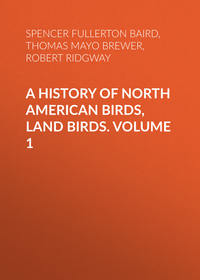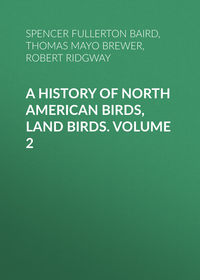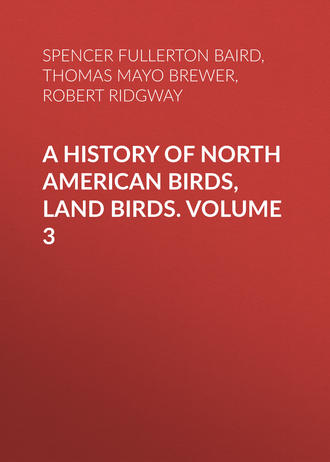 полная версия
полная версияA History of North American Birds, Land Birds. Volume 3
O. gruberi. Wing, 10.10; tail, 6.50; culmen, about .80; tarsus, 2.70; middle toe, 1.45; posterior claw, 1.00, its digit .80. Immature (?). Uniform grayish-umber, tinged with dull rufous on the neck; lining of the wing and tibiæ dull grayish-cinnamon. Primaries inclining to black, and showing just discernible, obscure hoary bars on their basal half. Tail brownish-gray, with a hoary cast nearer the shaft (not paler at the tip), and crossed with nine or ten narrow bars of dusky, these becoming hardly distinguishable basally and terminally. Inner webs of the primaries plain white anterior to their emargination. Head laterally and beneath obsoletely streaked with whitish. Hab. “California.”
Onychotes gruberi, RidgwayGRUBER’S HAWKOnychotes gruberi, Ridgway, Pr. Ac. Nat. Sc. Phil. Dec. 1870, p. 149.
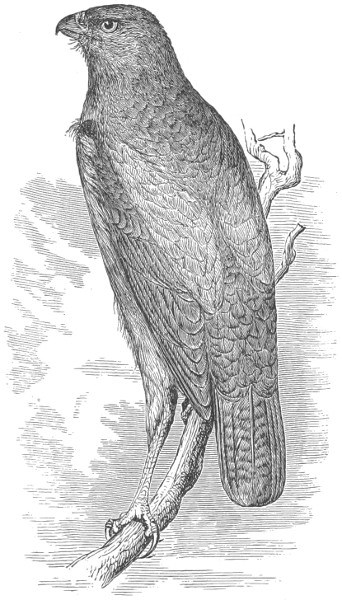
Onychotes gruberi.
Sp. Char. Immature? (41,703, “California”; F. Gruber). Outstretched feet reaching beyond tail. General plumage dull dark-bistre, with a grayish-umber cast in some lights, darkest on the head above and back; the posterior lower parts paler and more reddish; throat and neck much tinged with pale rusty (this obsoletely bordering the feathers, which here have fine whitish filaments attached to the shafts); primaries uniform black. Tail like the rump, but with a more hoary tinge (not paler at the tip), and crossed with seven or eight very narrow obscure bars of darker, the last of which is distant an inch or more from the end. Lining of wing dark bistre, much tinged with rusty, this prevalent toward the edge; under surface of primaries white anterior to their emargination, beyond which they are ashy, approaching black at ends; ashy portion with distant, very obsolete, dusky bars, but the cheeks and throat streaked obsoletely with this color. No distinct white anywhere about the head or neck. Wing, 10.00; tail, 5.80; tarsus, 2.70; middle toe, 1.40; inner, .90; outer, 1.10; posterior, .80; hind claw, 1.00 (chord); inner claw, .91; on front of tarsus, twelve exposed large transverse scutellæ; only 1.70 of the tarsus exposed.
The type of this species still remains unique. It was sent to the Smithsonian Institution by Mr. Gruber, who labelled it as having been obtained in California. Nothing is known of its habits.
Genus BUTEO, Cuvier
Buteo, Cuv. 1799. (Type, Falco buteo, Linn. = Buteo vulgaris, Bechstein.)
Craxirex, Gould, 1838. (Type, Buteo galapagoensis, Gould.)
Pæcilopternis, Kaup, 1847. (Type, Falco borealis, Gm.)
Tachytriorchis, Kaup, 1844. (Type, Falco pterocles, Temm.)
Gen. Char. Form robust and heavy, the wings long, and rather pointed, the tail moderate and rounded, the bill and feet strong. Bill intermediate between that of Astur and that of Parabuteo. Wing long and rather pointed, the third to fifth quill longest, the first shorter than eighth; three to four with inner webs emarginated. Tail moderate, slightly rounded.
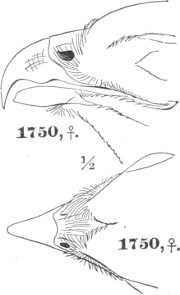
1750, ♀. ½
1750, ♀.
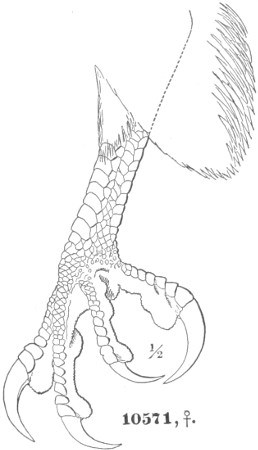
10571, ♀. ½

10571, ♀. ¼
Buteo borealis (1750; 10571).
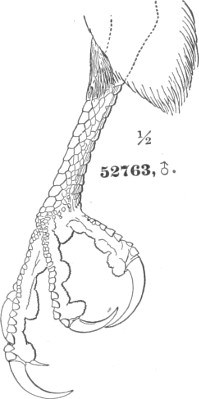
52763, ♂. ½
Buteo zonocercus (52763).

58505, ♀. ¼
Buteo swainsoni (58505).
The species of this genus are very numerous, especially within the tropics, and are found all over the world, except in Australia. About thirty nominal species are known, of which about fifteen distinct species, not including geographical races, belong to America. A single species, B. solitarius (Pandion solitarius, Peale), (Gray’s Hand List, I, 15, No. 136,) belongs to the Sandwich Islands. The genus seems to be wanting in the Australian and East Indian regions.
The following species and races belong to the North American fauna.
Species and RacesA. Three outer primaries with their inner webs cut or emarginated.
1. B. pennsylvanicus. Wing, 9.85–11.40; tail, 6.30–8.00; culmen, .70–.80; tarsus, 2.15–2.80; middle toe, 1.20–1.40. Third to fourth quill longest; first shorter than seventh. Adult. Tail dull black, paler at the tip, crossed by two to four bands of dilute umber, or brownish-white, varying in width, but the last always broadest. Upper tail-coverts tipped and barred with white. Lower parts dull rufous-brown, nearly unbroken on the breast, but posteriorly much variegated with roundish transverse spots of white, forming broad transverse bars, interrupted by the dusky shaft. Upper parts dark umber, darker on the back. Young. Tail dull grayish-umber, growing darker terminally, narrowly tipped with whitish, and crossed by about six narrow and indistinct bands of dusky; these gradually becoming obsolete basally, the last much broader. Lower parts white, or light ochraceous, with longitudinal spots of dark brown or blackish on the sides of the breast and abdomen, and roundish or transversely cordate ones on the sides, flanks, and tibiæ. A conspicuous “mustache” on the cheeks, from the rictus down. Upper parts much as in the adult. Hab. Eastern North America, and Middle America, south to Bogota and Caraccas.
2. B. swainsoni. Wing, 12.00–17.00; tail, 6.50–9.00; culmen, .80–.95; tarsus, 2.95–2.70; middle toe, 1.50–1.70. Third to fourth (usually third) quills longest; first usually longer than seventh. Adult. Tail dark grayish-brown, sometimes with a hoary cast, crossed by five to seven, or more, narrow bands of dusky, usually very obscure, and becoming obsolete basally. Colors of other portions extremely variable; the upper parts, however, continuous, unvariegated, dark brown, or blackish; the lower parts sometimes also entirely dusky, except the tail-coverts, which are always (?) barred with white. Normal plumage. A dark area covering the jugulum and breast, dull rufous in the ♂, and dark grayish-brown in the ♀. Other lower parts whitish, sometimes pure, and nearly immaculate, but usually more or less tinged with ochraceous and rufous, and transversely barred with various shades of brown. Young. Tail hoary brownish-gray, crossed by numerous, very indistinct, narrow bands of darker, and faintly tipped with whitish. Ground-color of the head, neck, and lower parts, light ochraceous, or cream-color (sometimes nearly white), the anterior upper parts with large longitudinally ovate spots of black; these assuming the form of streaks on the head and neck. Sides of the breast with an aggregation of larger spots of the same, and sides with sparser hastate or deltoid spots. Upper parts purplish-black, more or less variegated with ochraceous; the relative proportion of the two colors varying with the individual.
Wing, 14.40–17.00; tail, 8.00–9.50; culmen, .80–.95; tarsus, 2.30–2.70; middle toe, 1.50–1.70. Weight 1½–3½ lbs. Hab. Western Province of North America, from the Mississippi Valley, and the region of the Great Lakes (Michigan, Wisconsin, Iowa, to Arkansas, also Canada and Massachusetts) to the Pacific … var. swainsoni.
Wing, 12.00–15.30; tail, 6.50–9.00; culmen, .85–.90; tarsus, 1.95–2.60; middle toe, 1.50–1.60. Colors similar, but the young paler than that of var. swainsoni. Adult unknown. Hab. Middle and South America, and southern border of the western United States, from New Mexico to Buenos Ayres (two specimens, Costa Rica, and Buenos Ayres, Mus. S. I.) … var. oxypterus.
B. Four outer primaries with their inner webs cut.
a. Form light, the legs slender; tail of adult without a subterminal band of black more distinct than the others.
3. B. zonocercus. Wing, 15.50–17.40; tail, 8.50–10.75; culmen, .90; tarsus, 2.50–2.80; middle toe, 1.60–1.85. Entirely deep black, with more or less concealed pure white spotting. Adult. Tail carbonaceous-black, with three very broad zones, of pure white on inner webs and ash on the outer webs. Young. Tail dark brown, the inner webs more or less, sometimes entirely, white, crossed by numerous oblique bands of black. Hab. Mexico (chiefly western?) and adjacent southwestern portions of the United States (Arizona, Coues; Southern California, San Diego, Cooper).
4. B. lineatus. Wing, 11.25–14.25; tail, 8.00–10.00; culmen, .75–.90; tarsus, 2.70–3.25; middle toe, 1.30–1.50. Fourth to fifth quill longest; first shorter than seventh. Outer webs of the primaries with quadrate spots of whitish; lesser wing-coverts dark rufous; lower parts rufous more or less barred with whitish, or whitish spotted longitudinally with dusky. Adult. Head, neck, lesser wing-coverts, and lower parts deep rufous, the lower parts more or less barred posteriorly with whitish. Primaries and tail black; the former with quadrate spots of pure white on the outer webs, and the latter crossed by six narrow bands of pure white, and tipped with the same. Young. Head, neck, and lower parts whitish, usually more or less tinged with ochraceous, and with longitudinal markings of dusky. Primaries and tail dusky; the former mostly ochraceous anterior to the sinuation of their outer webs, the latter crossed by numerous narrow bands of pale grayish-brown, these becoming paler and more ochraceous toward the base. Lesser wing-coverts more or less tinged with dark rufous.
Adult. Lower parts light rufous barred with white. Young. White prevailing on the lower parts. Hab. Eastern Province of the United States … var. lineatus.
Adult. Lower parts deep dark rufous, almost free from bars, except posteriorly. Young. Dark spotting on the lower parts predominating. Hab. Pacific Province, and southern Western Province, of the United States … var. elegans.
b. Form robust and heavy, the tarsus stout; tail of the adult with a subterminal band of black broader than the other.
5. B. borealis. Wing, 13.25–17.75; tail, 8.50–11.30; culmen, .90–1.15; tarsus, 2.70–3.40; middle toe, 1.60–1.95. Weight, 2½ to 4 lbs. Third to fifth quill longest; first shorter than seventh and shorter than tenth. Colors extremely variable, ranging from entirely pure white beneath, through various shades of ochraceous and rusty, and greater or less amount of darker spots and bars, to an entirely uniform brownish-black. Adult. Tail deep rufous, generally paler at the tip; with or without black bars. Young. Tail grayish-brown, crossed by nine or ten bands of black, much narrower than the gray ones. Lower parts always with white predominating.
Tibiæ and lower tail-coverts without transverse bars, at any age. Lower parts with white always predominating. Tail never with more than one bar of black.
Feathers of the head and neck edged laterally with rufous; scapulars and wing-coverts much variegated with whitish; upper tail-coverts white, barred with rufous. Throat with blended streaks of blackish, this usually predominating; tibiæ and lower tail-coverts plain yellowish-white. Hab. Eastern Province of North America, to the Missouri plains … var. borealis.
Similar, but colors much paler, the lower parts entirely pure white, with little or no spotting on the abdomen. Tail usually destitute of the black subterminal band. Hab. Plains, from Texas to Minnesota … var. krideri.
Similar to the last, but lower parts strongly tinged with rufous on the tibiæ, and upper parts much darker. Tail always destitute of the subterminal black band. Young not distinguishable from that of var. calurus. Hab. Cape St. Lucas … var. lucasanus.
Whole head, neck (except the throat), and upper parts, continuously uniform unvariegated brownish-black; that of the neck meeting narrowly across the lower part of the throat, leaving the whole throat almost immaculate white. Posterior lower parts fine, deep pinkish-ochraceous; tibiæ deep reddish-ochraceous; upper tail-coverts plain rufous. Hab. Central America (from Tres Marias, Western Mexico, to Costa Rica and Veragua) … var. costaricensis.
Tibiæ and lower tail-coverts always with distinct transverse bars. Tail often with more or less complete transverse bars of black to the base. Lower parts with an excess of ochraceous and darker markings, frequently wholly blackish.
Varying, from individuals distinguishable from the darker examples of var. borealis only by the presence of bars on the tibiæ and crissum, through others with various degrees of rufous tinge and dusky spotting and barring beneath, to a perfectly melanistic condition, in which the bird is almost uniformly black, and the tail with continuous, regular bars of black to the base. Hab. Western Province of North America, from the Rocky Mountains to the Pacific … var. calurus.
6. B. harlani. Wing, 15.00–16.20; tail, 8.80–10.50; culmen, 1.00; tarsus, 2.75–2.90; middle toe, 1.50–1.70. Lateral toes nearly equal; tibial plumes much developed, reaching below the bases of the toes. Entirely brownish-black (except the tail), the concealed bases of the feathers snowy-white. Adult. Tail confusedly mottled with dusky and white, upon a grayish ground; sometimes more or less tinged with rufous. Young. Tail grayish-brown, with nine very regular, sharply defined bands of brownish-black, about equal in width to the gray ones. Lower parts wholly dusky. Hab. Southwestern United States, east of the Rocky Mountains, from Kansas to Texas.
7. B. cooperi. Wing, 15.75; tail, 9.10; culmen, 1.10; tarsus, 3.25; middle toe, 1.70. Adult. Head, neck, and beneath, pure white, the head above and nape streaked with dusky; lining of the wing white, with a large black patch. Above nearly uniform dusky, the primaries plumbeous. Tail longitudinally mottled with light rufous, cinereous, and dusky; the former prevailing. Hab. Santa Clara County, California.
Buteo pennsylvanicus (Wils.)BROAD-WINGED HAWKFalco pennsylvanicus, Wils. Am. Orn. VI, 92, pl. liv, f. 1, 1812.—Lath. Gen. Hist. I, 263, 1821.—Aud. B. Am. pl. xci, 1831; Orn. Biog. I, 461, 1831.—Bonap. Ann. Lyc. N. Y. II, 29, 434; Isis, p. 1137, 1832.—Nutt. Man. I, 105, 1833.—Temm. Pl. Col. 67, 1836. Buteo pennsylvanicus, Bonap. Ois. Cuv. Règ. An. p. 35, 1830; Eur. & N. Am. B. p. 3, 1838; Consp. Av. p. 19, 1850.—Aud. Syn. p. 7, 1839.—Brew. (Wils). Am. Orn. Syn. p. 648, 1852.—Gray, Gen. sp. 8, 1844; List B. Brit. Mus. p. 16, 1844.—Cass. B. Cal. & Tex. Syn. p. 100, 1854.—Strickl. Orn. Syn. I, 32, 1855.—De Kay, Zoöl. N. Y. II, 11, pl. v, fig. 11, 1844.—Cass. Birds N. Am. 29, 1858.—Gray, Hand List, B. 7, 1869.—Dresser, Ibis, 1865, 325 (Texas). Astur pennsylvanicus, Cuv. Règ. An. (ed. 2), I, 332, 1829.—James. (Wils.) Orn. I, 65. Falco latissimus, Wils. Am. Orn. (last ed.) VI, 92, pl. liv, f. 1, 1812. A. ? latissimus, Jard. (Wils.) Am. Orn. II, 294. Falco wilsoni, Bonap. Obs. Wils. Nouv. Journ. Ac. Sc. N. Y. III, 348. Pœcilopternis wilsoni, Kaup, Mon. Fal. Cont. Orn. p. 75, 1850. Sparvius platypterus, Vieill. Enc. Méth. III, 1273 (quot. Wils. pl. liv, fig. 1), 1823.
Sp. Char. Adult. Upper surface dark umber-brown, the feathers gradually paler toward edges; on the back, the feathers more uniformly dusky, causing a prevalent blackish appearance. Rump and upper tail-coverts blackish vandyke-brown; the latter tipped with pure white, and with a concealed bar of same, about the middle of each feather. Tail dull black, with an obscure terminal band of dull brown, this fading terminally into whitish; across the middle of the tail a broad band of dull light umber (in some individuals approaching dull white) about ¾ of an inch in width; about as far anterior to the main band as this is from the tip is another much narrower and more obscure band of the same color, crossing just beyond the ends of the coverts, or concealed by them. Primaries uniform brownish-black, fading on terminal edge into pale brown. Head above, and broad but inconspicuous “mustache,” running from beneath the lore downward across the cheek, dull black; the crown posteriorly, with the occiput and nape, having the dull black much broken, caused by the lateral streaks of dull rufous on all the feathers; this dull rufous tint prevails on the rest of the head and neck, as well as the breast, leaving the lores and chin and lateral portion of frontlet alone whitish; throat streaked with blackish. Beneath dull brownish-rufous; that of the breast almost unvaried; medially, however, are roundish spots of white on opposite webs, but these are not confluent; posteriorly these spots become gradually more numerous and more transverse, forming on the flanks transverse bands, almost continuous; on the tibiæ the white prevails, the rufous bars being more distant, and connected only by a brown shaft-line; lower tail-coverts less numerous, transverse spots of dull rufous. Lining of the wing ochraceous-white, with sparse, rather small, irregularly deltoid spots of dull rufous; under surface of the primaries unvaried white, as far as their emargination, beyond which they are black. Fourth quill longest; third a little shorter; second intermediate between fifth and sixth; first about equal to the ninth. Female (extremes 30,969, Brookline, Mass., and 30,895, Mirador, Mexico; the latter the larger.) Wing, 11.00–11.30; tail, 6.80–7.10; tarsus, 2.30; middle toe, 1.30. Male (32,309, Moose Factory, Hudson’s Bay Territory). Wing, 10.50; tail, 6.30; tarsus, 2.30; middle toe, 1.20.
Young male, second year? (39,106, Remedios, Cuba, June; N. H. Bishop). Upper parts similar to adult, but a reddish tint appreciably washing the edges of the interscapulars and (less noticeably so) the scapulars. Bands on tail nearly as in adult; but very near the base is a fourth, very narrow and faintly defined, pale band, while the bases of all the feathers are much mottled with white. Dull rufous of the breast not continuous, but in the form of large longitudinal broad spots, occupying the greater middle portion of each feather; abdomen, sides, and tibiæ with smaller and more cordate spots of dull rufous; the lower tail-coverts immaculate; the decided ochraceous tinge beneath, deepest posteriorly.
Young, first year (11,984, Washington, D. C.). The blackish above is much variegated, being broken by the narrow rusty borders to interscapulars, rump, and lesser wing-coverts; the broader and more ochraceous borders to scapulars and greater wing-coverts, and partially concealed whitish spotting on the former. Upper tail-coverts white, with broad bars of blackish-brown; secondaries and primaries edged terminally with whitish. Tail dull umber-brown, growing darker terminally; narrowly tipped with white, and crossed with six obscure, narrow bands of dusky, the (concealed) bases of all the feathers white. Superciliary region, cheeks, chin, throat, and entire lower parts, delicate pale ochraceous, or whitish cream-color; a conspicuous “mustache,” a medial longitudinal series of streaks on the throat, with large longitudinal ovate spots on sides of breast, cordate spots on sides and flanks, and sagittate spots on tibiæ, clear blackish-brown. The ochraceous deepest on the abdomen and crissum. Wing beneath as in adult.
A very young bird, scarcely fledged (33,598, Milltown, Me.; G. A. Boardman), differs from the last in a much more continuous black shade above, the deeper ochraceous beneath, and larger, as well as more numerous, blackish spots beneath.
In the adult plumage of this species, the principal variation is in the continuity or distinctness of the anterior light band on the tail, and the extent and depth of shade of the brown beneath. The first feature is characteristic of most specimens, only one (55,980, ♂, Costa Rica) being without it; it is broadest and most conspicuous, as well as less concealed by the coverts, in the females, and this appears to be the principal sexual difference. The dull brownish-rufous of the under parts is most prevalent in a specimen from Mirador, Mexico (30,895, ♀ ? September; Dr. Sartorius), in which specimen the breast is almost continuously of this color, and the lower tail-coverts are strongly barred (or transversely spotted) with the same; the ground-color beneath is also more ochraceous than in any other individual. In the Costa-Rican specimen (the one lacking the anterior tail-band), the brown beneath is quite different from that of the others, being of a much more ashy shade; the lower tail-coverts are also immaculate. The brown markings beneath are most sparse in 20,389, from Coban, Vera Paz (January; O. Salvin); in this, also, the tail-bands are very distinct, and almost white.
A young bird from Costa Rica (30,412; Dr. Frantzius) is exactly similar to No. 27,048, from Fort Garry, Selkirk Settlement.
LIST OF SPECIMENS EXAMINEDNational Museum, 18; Philadelphia Academy, 6; Boston Society, 3; New York Museum, 2 (Caraccas); Museum, Cambridge, 2; Cab. G. N. Lawrence, 5; Coll. R. Ridgway, 2. Total, 38.

Hab. Eastern North America southward along Gulf coast through Louisiana, into Mexico and Central America; Cuba, Ecuador, Upper Amazon, Caraccas (N. Y. Museum).
Localities: Ecuador, winter (Scl. 1858, 451); Orizaba (Scl. 1857, 211); Upper Amazon (Scl. 1857, 261); Cuba (Cab. Journ. II, lxxxii; Gundlach, Rept. 1865, 223; resident); Panama (Lawr. VII, 1861, 288); S. E. Texas (Dresser, Ibis, 1865, 325; breeds); Costa Rica (Lawr. IX, 133).
Habits. The Broad-winged Hawk appears to be distributed over eastern North America, somewhat irregularly, as far north as the British Provinces, and as far west at least as the Mississippi. It has been found in Florida by Mr. Wurdemann, where it was said to be not uncommon. It is a resident in Cuba, where it breeds; but it has not been taken in Jamaica. It has also been detected in Guatemala by Mr. Skinner. Audubon states that he never met with it in Louisiana, but Mr. Dresser found it not uncommon from the Nueces eastward. In September he noticed several near the Mission of San Patricio, and during the winter obtained several specimens near San Antonio. In May he shot a young bird on the Medina River, and early in June he found a nest containing young on the Colorado. It was on a high cottonwood-tree, and in an almost inaccessible position.
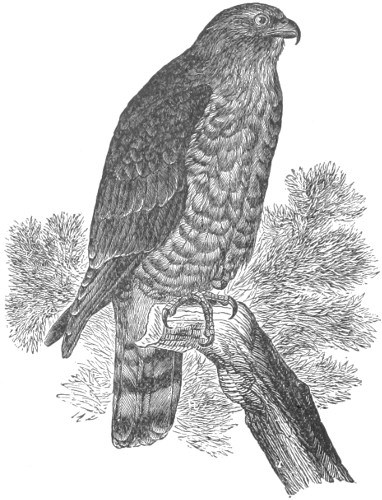
Buteo pennsylvanicus.
It is not mentioned by Mr. Downes as occurring in Nova Scotia, though I think it quite probable it may be found there; but it is quite common near Calais, both in Eastern Maine and in New Brunswick. Professor Verrill gives it as a common summer visitant in Oxford County, Me., near Norway, and as still more abundant near the Umbagog Lakes, and apparently the most common Hawk in that vicinity. He found its nest, June 12, containing two eggs nearly hatched. It is to be met with throughout Massachusetts, having been found breeding near Williamstown, Springfield, and also in the vicinity of Boston. Its nest was also met with in Middlebury, Vt., by the late Professor Adams. Mr. McIlwraith, of Hamilton, Canada, has noted extensive migrations of this Hawk in March of different years, as many as twenty or thirty being in view at one time, passing at a considerable height, and moving in circles towards the northwest. Others, that appeared to be stragglers from the main body, were met with in the woods. Dr. Hoy states it to be rather common near Racine, and Mr. Kumlien has obtained it in the vicinity of Lake Koskonong. From all these data it may naturally be inferred that this Hawk has a pretty general distribution from Florida to Texas, and from New Brunswick to the Mississippi Valley, probably extending northward into the Saskatchewan Valley and south-westerly to Central America.


